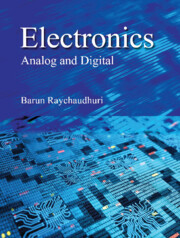Book contents
Summary
This chapter includes two different topics well related to electronic devices and circuits. One is the technology of fabricating integrated circuit (IC) and the other is the construction of measuring instruments, mainly concentrated on cathode ray oscilloscope (CRO).
Integrated Circuit (IC)
An integrated circuit (IC) is a complete miniature circuit comprising active elements, such as diodes and transistors and passive elements, such as resistors and capacitors, all fabricated on a single chip of semiconductor, mostly silicon. American engineer Jack Kilby (1923–2005) and American physicist Robert Noyce (1927–1990) independently invented the principle of IC in 1958 and 1959, respectively. ICs are indispensable components of almost all modern electronic appliances ranging from computer, television, smartphone and other household gadgets to the critical advancing on missiles and artificial satellites.
Use of IC in electronic circuits has a number of advantageous features over the bulky circuits made of interconnected discrete components. The most significant benefits are the followings.
Miniaturization: Fabrication of small-size devices is the most noted advantage of IC. Indeed the word ‘microelectronics’ became popular after the arrival of IC. Accommodating more than 108 transistors within a chip of only 1 cm2 is a very common feature in today's IC technology.
Batch Processing: Millions of ICs can be fabricated at a time from a single piece of semiconductor. The process reduces the cost and provides with good matching among the devices.
Improved Performance: The reliability of the working of ICs is very good because the possible faults due to interconnection of discrete components is eliminated. Small size and light weight make the circuit suitable for airborne, space-based and other vital equipment.
Maintenance: It consumes less power and the entire circuit can be replaced easily at less cost.
In spite of the above benefits, ICs have some limitations, as follows.
• Transistors capable of handling high power cannot be fabricated on IC.
• Inductors and transformers cannot be fabricated on IC.
• IC technology is not suitable for high value capacitors, such as 100–1000 μF.
• Precision resistors having tolerance less than 1% are not possible with IC.
As a whole, the range of IC-fabricated passive components is quite restricted. The power handling capability of IC components is low and the components may be sensitive to voltage and static charge.
- Type
- Chapter
- Information
- Electronics , pp. 432 - 459Publisher: Cambridge University PressPrint publication year: 2023



